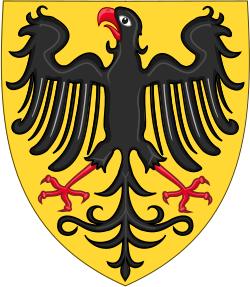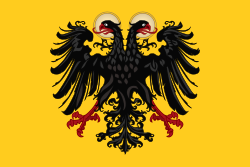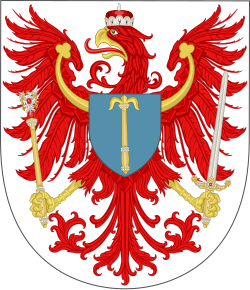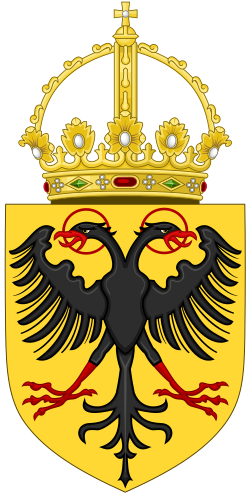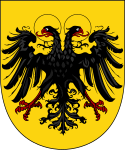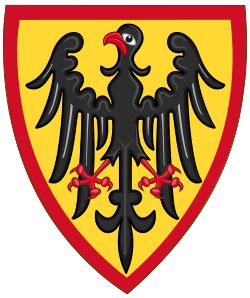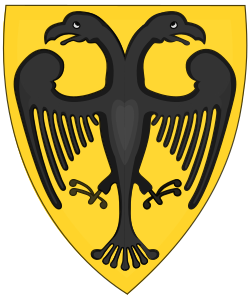Znaky Svaté říše římské

Svatá říše římská neměla během celé své existence žádný jednotný a ustálený znak. Dlouhodobě jako jednotící symbol existoval černý orel s červenou zbrojí – nejprve jednohlavá orlice, od druhé poloviny 14. století byl zobrazován dvouhlavý orel, přičemž většinou byl/a umisťován/a na zlatém poli, ale někdy se objevoval/a také zcela samostatně.
Od nástupu Alberta II. v roce 1438 začala tradice, kdy znakem každého císaře byl dvouhlavý říšský orel, do něhož byl vložen osobní znak z doby před nástupem, tyto znaky byly ovšem stále osobními erby jednotlivých císařů, nikoliv znaky státu jako takového.
Reichsadler
- znak s říšskou orlicí, s orlem:
1190–1197
(znak Jindřicha II., Codex Manesse)13. století–asi 1430
13. století–asi 1430 (bez červené zbroje)
13. století
(znak Oty IV. v letech 1209–1218 přisouzený Chronica Majora)
- znak s korunou:
Orel se štíty


Jako obecný reprezentativní symbol byl užíván orel se štíty. Poprvé byl vyobrazen v roce 1510, kdy jeho dřevořez vytvořil Hans Burgkmair a následně byl téhož roku otištěn jako součást knižní ilustrace. Burgkmairův orel na sobě nese vyobrazení znaků 56 vybraných států Říše.
- orel se štíty:
z roku 1510
Orel Hanse Burgkmaira má v horní řadě ve větším měřítku vyobrazené štíty tehdejších států kurfiřtských, na pravém křídle jsou to státy duchovní (arcibiskupství trevírské, arcibiskupství kolínské a arcibiskupství mohučské, dále znak titulárního kurfiřta, prefekta římského) a na levém křídle potom znaky světských států (Českého království, falckého kurfiřtství, saského kurfiřtství a Braniborského markrabství).
Odkazy
Reference
V tomto článku byl použit překlad textu z článku Armorial of the Holy Roman Empire na anglické Wikipedii.
Související články
Externí odkazy
 Obrázky, zvuky či videa k tématu Znaky Svaté říše římské na Wikimedia Commons
Obrázky, zvuky či videa k tématu Znaky Svaté říše římské na Wikimedia Commons
Média použitá na této stránce
Autor: Ziegelbrenner, Licence: CC BY-SA 3.0
Coats of arms of the electorate of Salzburg. 1+2: prince archbishop of Salzburg; 3. prince-bishop of Eichstätt; 4. prince-bishop of Passau; 5. prince-provost of Berchtesgaden; middle: 1 Old-Hungary; 2. New-Hungary; 3: Bohemia; 4: county of Tirol; 5: grand-duchy of Tuscany; 5: duchy of Lorraine; 5: county of Habsburg; heart: Austria
Autor: Heralder & Tom Lemmens, Licence: CC BY-SA 3.0
Shield and Coat of Arms of the Holy Roman Emperor, drawn in the style the late medieval period.
Also used as shield of arms (generic) by the King of the Romans
Coat of arms of Baden, Markgrafschaft
Autor: Adelbrecht and Heralder, elements by Sodacan, Licence: CC BY-SA 3.0
Shield of Arms of the Arch-Marshal of the Holy Roman Empire.
Gold crown
Autor: Gundan, + my own edits, Licence: CC BY-SA 4.0
I principati elettorali del Sacro Romano Impero nel 1618
Autor: Ad17minstral, Licence: CC BY-SA 4.0
Arms of electoral Württemberg augmented with heraldic insignia of the imperial office of the Banner-bearer.
Autor: Ad17minstral, Licence: CC BY-SA 4.0
Silver Bohemian lion presenting a crown symbolizing the imperial crown of the Holy Roman Empire presented by the Arch Cupbearer—the King of Bohemia—at imperial coronations. Restored from hand-drawn Medieval armorials.
Autor: Adelbrecht and Heralder, elements by Sodacan, Licence: CC BY-SA 3.0
Shield of Arms of the Arch-Treasurer of the Holy Roman Empire.
Autor: Heralder & Tom Lemmens, Licence: CC BY-SA 3.0
Shield and Coat of Arms of the Holy Roman Emperor, based on the depiction in Codex Manesse (c. 1310). An imperial coat of arms in this style was in use from c. 1200 to c. 1430. From 1433 (accession of Sigismund), use of the double-headed eagle became prevalent. The shield shape used here is typical of the early to mid 14th century. A variant with a shield shape more typical of the late 14th to early 15th century can be found here.
Autor: Tom Lemmens & Heralder, Licence: CC BY-SA 3.0
Double-headed Reichsadler, Heraldic shield of the Holy Roman Emperor, from Wernigeroder Wappenbuch (c. 1475-1500) [the heads should be crowned]
Autor: Pakeha, Licence: CC BY-SA 4.0
Heraldische Malereien, u.a. Quaternionenadler des Heiligen Römischen Reiches und möglicherweise der Königreiche Frankreich, England, Sizilien und Schottland, an der Herzog-Friedrich-Straße in der Innsbrucker Altstadt.
Autor: Původní dílo: Hans Burgkmair. Vektorizace: Ssolbergj, Licence: CC BY-SA 3.0
SVG version of the Quaternion Eagle (Quaternionenadler), an eagle of the Holy Roman Empire that shows the shields of the member states by rank (1510), based on original woodcut of Hans Burgkmair and Jost de Negker, not official adopted coat of arms of the Holy Roman Empire.
Autor: David Liuzzo, eagle by N3MO, Licence: CC BY-SA 3.0
Banner of the Holy Roman Empire, double headed eagle with halos (1400-1806)
Autor: Glasshouse, Licence: CC BY-SA 4.0
Shield of the Prussian State of Brandenburg
Autor: Adelbrecht and Heralder, elements by Sodacan, Licence: CC BY-SA 3.0
Shield of Arms of the Arch-Steward of the Holy Roman Empire.
Autor: Tom Lemmens & Heralder, Licence: CC BY-SA 3.0
Coat of Arms of the Holy Roman Emperor (c.1433-c.1450)
Autor: Heralder & Tom Lemmens, Licence: CC BY-SA 3.0
Coat of Arms of the Holy Roman Emperor (c.1400-c.1433)
Autor: MostEpic, Licence: CC BY-SA 4.0
Shield of Arms of the Arch-Bannerbearer of the Holy Roman Empire.
(c) I, N3MO, CC BY-SA 3.0
Coat of arms of the Holy Roman Empire from ca. 1433
(emperor Sigismund was the first to use the double-headed eagle, but the single-headed eagle continued to see some use well into the 16th century).
The style is loosely based on that of the mid-16th century (cf. e.g. Jacob Kallenberg (1545)), but largely equivalent designs were used in heraldry well into the 19th century.Autor: Ipankonin, Licence: CC BY-SA 3.0
Coat of arms of the Archbishopric of Mainz
Blazon: Gules a wheel with six spokes argent.Autor: MostEpic, Licence: CC BY-SA 4.0
Coat of arms of the house of Hesse-Kassel
Autor: Heralder & Tom Lemmens, Licence: CC BY-SA 3.0
Attributed coat of arms of Henry VI, Holy Roman Emperor (died 1197). (Recreation of painting in Codex Manesse c.1304)
Autor: Heralder & Tom Lemmens, Licence: CC BY-SA 3.0
First depiction of the Reichsadler as double-headed (attributed coat and shield of arms of Otto IV, Holy Roman Emperor from the w:Chronica Majora, c. 1250)
Autor: FDRMRZUSA, Licence: CC BY-SA 4.0
Shield and Coat of Arms of the Holy Roman Emperor, based on the depiction in Codex Manesse (c. 1310). An imperial coat of arms in this style was in use from c. 1200 to c. 1430. From 1433 (accession of Sigismund), use of the double-headed eagle became prevalent. The shield shape used here is typical of the early to mid 14th century.
Autor: Adelbrecht and Heralder, elements by Sodacan, Licence: CC BY-SA 3.0
Ancient Shield of Arms of the Arch-Chamberlain of the Holy Roman Empire.
Autor: ชาวไทย, Licence: CC BY-SA 4.0
Coat of Arms of Electorate of Cologne and the Archdiocese of Cologne.
Autor:
- Royal_Arms_of_the_Kingdom_of_Hanover.svg: Sodacan
- derivative work: Sodacan (talk)
Royal Shield of Arms of the Kingdom of Hanover













